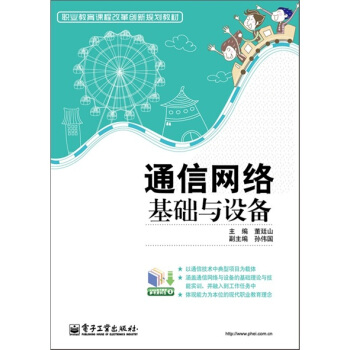![国外电子信息精品著作:高频CMOS模拟集成电路基础(影印版) [Fundamentals of High-Frequency CMOS Analog Integrated Circuits]](https://pic.windowsfront.com/10708550/5398fc86N04a572cf.jpg)

具体描述
编辑推荐
· With a design-centric approach, this textbook bridges the gap between fundamentalanalog electronic circuit textbooks and more advanced RF IC design texts.· The major issues that must be taken into account when combining analog and digitalcircuit building blocks are covered, together with the key criteria and parameters thatare used to describe system-level performance.
· Simple circuit models enable a robust understanding of high-frequency designfundamentals, and SPICE simulations are used to check results and fine-tune the design.
· Analog integrated circuit designers and RF circuit designers in industry who needhelp making design choices will also find this a practical and valuable reference.
内容简介
《高频CMOS模拟集成电路基础(影印版)》以设计为核心理念从基础模拟电路讲述到射频集成电路的研发。系统地介绍了高频集成电路体系的构建与运行,重点讲解了晶体管级电路的工作体系,设备性能影响及伴随响应,以及时域和频域上的输入输出特性。《高频CMOS模拟集成电路基础(影印版)》适合电子信息专业的高年级本科生及研究生作为RFCMOS电路设计相关课程的教材使用,也适合模拟电路及射频电路工程师作为参考使用。
目录
Preface1 Components of analog CMOS ICs
1.1 MOS transistors
1.1.1 Current-voltage relations of MOS transistors
1.1.1.1 The basic current-voltage relations without velocity saturation
1.1.1.2 Current-voltage relations under velocity saturation
1.1.1.3 The sub-threshold regime
1.1.2 Determination of model parameters and related secondary effects
1.1.2.1 Mobility
1.1.2.2 Gate capacitance
1.1.2.3 Threshold voltage
1.1.2.4 Channel length modulation factor
1.1.2.5 Gate length (L) and gate width (W)
1.1.3 Parasitics of MOS transistors
1.1.3.1 Parasitic capacitances
1.1.3.2 The high-frequency figure of merit
1.1.3.3 The parasitic resistances
1.2 Passive on-chip components
1.2.1 On-chip resistors
1.2.2 On-chip capacitors
1.2.2.1 Passive on-chip capacitors
1.2.2.2 Varactors
1.2.3 On-chip inductors
2 Basic MOS amplifiers: DC and low-frequency behavior
2.1 Common source (grounded source) amplifier
2.1.1 Biasing
2.1.2 The small-signal equivalent circuit
2.2 Active transistor loaded MOS amplifier(CMOS inverter as analog amplifier)
2.3 Common-gate (grounded-gate) amplifier
2.4 Common-drain amplifier (source follower)
2.5 The long tailed pair
2.5.1 The large signal behavior of the long tailed pair
2.5.2 Common-mode feedback
3 High-frequency behavior of basic amplifiers
3.1 High-frequency behavior of a common-source amplifier
3.1.1 The R-C load case
3.2 The source follower amplifier at radio frequencies
3.3 The common-gate amplifier at high frequencies
3.4 The cascode amplifier
3.5 The CMOS inverter as a transimpedance amplifier
3.6 MOS transistor with source degeneration at high frequencies
3.7 High-frequency behavior of differential amplifiers
3.7.1 The R-C loaded long tailed pair
3.7.2 The fully differential, current-mirror loaded amplifier
3.7.3 Frequency response of a single-ended output long tailed pair
3.7.4 On the input and output admittances of the long tailed pair
3.8 Gain enhancement techniques for high-frequency amplifiers
3.8.1 Additive approach: distributed amplifiers
3.8.2 Cascading strategies for basic gain stages
3.8.3 An example: the Cherry-Hooper amplifier
4 Frequency-selective RF circuits
4.1 Resonance circuits
4.1.1 The parallel resonance circuit
4.1.1.1 The quality factor of a resonance circuit
4.1.1.2 The quality factor from a different point of view
4.1.1.3 The Q enhancement
4.1.1.4 Bandwidth of a parallel resonance circuit
4.1.1.5 Currents of L and C branches of a parallel resonance circuit
4.1.2 The series resonance circuit
4.1.2.1 Component voltages in a series resonance circuit
4.2 Tuned amplifiers
4.2.1 The common-sot/rce tuned amplifier
4.2.2 Thi tuned cascode amplifier
4.3 Cascaded tuned stages and the staggered tuning
4.4 Amplifiers loaded with coupled resonance circuits
4.4.1 Magnetic coupling
4.4.2 Capacitive coupling
4.5 The gyrator: a valuable tool to realize high-value on-chip inductances
4.5.1 Parasitics of a non-ideal gyrator
4.5.2 Dynamic range of a gyrat0r-based inductor
4.6 The low-noise amplifier (LNA)
4.6.1 Input impedance matching
4.6.2 Basic circuits suitable for LNAs
4.6.3 Noise in amplifiers
4.6.3.1 Thermal noise of a resistor
4.6.3.2 Thermal noise of a MOS transistor
4.6.4 Noise in LNAs
4.6.5 The differential LNA
5 L-C oscillators
5.1 The negative resistance approach to L-C oscillators
5.2 The feedback approach to L-C oscillators
5.3 Frequency stability of L-C oscillators
5.3.1 Crystal oscillators
5.3.2 The phase-lock technique
5.3.3 Phase noise in oscillators
6 Analog-digital interface and system-level design considerations
6.1 General observations
6.2 Discrete-time sampling
6.3 Influence of sampling clock jitter
6.4 Quantization noise
6.5 Converter specifications
6.5.1 Static specifications
6.5.2 Frequency-domain dynamic specifications
6.6 Additional observations on noise in high-frequency ICs
Appendix A Mobility degradation due to the transversal field
Appendix B Characteristic curves and parameters of AMS 0.35 micron NMOS and PMOS transistors
Appendix C BSIM3-v3 parameters of AMS 0.35 micron NMOS and PMOS transistors
Appendix D Current sources and current mirrors
D.1 DC current sources
D.2 Frequency characteristics of basic current mirrors
D.2.1 Frequency characteristics for normal saturation
D.2.2 Frequency characteristics under velocity saturation
References
Index
前言/序言
用户评价
这本书《高频CMOS模拟集成电路基础》以一种非常前沿且深入的方式,为读者展现了高频CMOS模拟集成电路设计的复杂世界。我之所以对这类书籍情有独钟,是因为我认为模拟集成电路的设计,特别是涉及到高频领域,就像是在精密的仪器上进行艺术创作,需要在理论的框架内,最大化地发挥器件的潜力,同时规避掉各种不利因素。 本书的一个显著特点是,它并没有局限于对标准CMOS器件的描述,而是详细探讨了在高频下,这些器件所表现出的非理想特性,例如频率相关的跨导、输出电阻变化,以及各种寄生电容和电感的建模与分析。这些内容对于理解和设计高性能的高频电路至关重要,往往是许多基础教材中会略过的部分。书中对这些效应的分析,不仅有定性的描述,更有量化的模型,使得读者能够将其应用于仿真和实际设计中。 我尤其喜欢书中对不同类型的高频电路设计策略的比较和分析。比如,在讲解低噪声放大器(LNA)的设计时,它会详细对比使用共源、共栅、共漏等不同拓扑结构在高频下的优劣,并给出在特定应用场景下的设计建议。这种对比分析,能够帮助读者建立起一个全局的视角,理解不同设计选择背后的权衡和考量。 另外,本书在讲解某些复杂概念时,善于运用生动的类比和直观的图示,这大大降低了理解的难度。我曾经在阅读其他相关书籍时,对某些高频效应感到困惑,但在阅读这本书的相应章节后,豁然开朗。作者的讲解方式,能够有效地将抽象的理论转化为易于理解的物理概念。 毫无疑问,《高频CMOS模拟集成电路基础》是一本非常具有深度和广度的专业书籍。它不仅仅是一本技术手册,更像是一位经验丰富的导师,引导读者在高频CMOS模拟集成电路设计的道路上不断探索和进步。我非常推荐这本书给任何对该领域有深入研究需求的工程师、研究人员和高年级学生。它所提供的知识体系,将对你的设计能力和理论认知产生深远的影响。
评分这本《高频CMOS模拟集成电路基础》以一种非常独特的视角,呈现了高频CMOS模拟集成电路设计的方方面面。我一直认为,模拟集成电路的设计,尤其是高频部分的,是一个既需要扎实的理论功底,又需要丰富实践经验的领域。很多书籍在理论推导上做得很好,但在如何将这些理论落地到实际芯片设计中,却显得有些力不从心。而这本书,在这一点上做得相当出色。 书中的章节安排非常有逻辑性,从基础的CMOS器件在高频下的行为特征开始,到不同类型的高频电路模块,如低噪声放大器(LNA)、混频器、锁相环(PLL)等。它并没有简单地罗列这些电路的结构,而是深入分析了它们在高频工作时的关键性能指标,以及影响这些指标的各种因素。我特别喜欢它关于LNA设计的章节,对于增益、噪声系数、线性度之间的权衡,给出了非常细致的讲解和优化思路。 本书的另一大亮点在于其对版图效应的重视。在高频设计中,版图往往会对电路性能产生至关重要的影响,而这常常是理论书籍容易忽略的部分。这本书不仅讨论了寄生效应,还给出了具体的版图设计原则和技巧,以最小化这些不利影响。例如,它详细介绍了差分对的版图对称性对于抑制偶模噪声的重要性,以及如何合理布局电感等。这些内容对于实际的芯片设计工作者来说,是极其宝贵的经验。 当然,这本书的阅读并非易事,它需要读者具备一定的模拟电路基础知识,并且愿意花时间和精力去理解那些复杂的数学模型和分析方法。但正如任何一本优秀的工程技术书籍一样,它所带来的回报是巨大的。我通过阅读这本书,对很多曾经模糊的概念有了更清晰的认识,并且在解决一些长期困扰我的设计难题时,找到了新的方向。 总而言之,《高频CMOS模拟集成电路基础》是一本不可多得的优秀教材。它不仅能帮助读者构建起对高频CMOS模拟集成电路的全面认知,更能培养出一种严谨细致的设计思维。我强烈推荐这本书给所有在模拟IC设计领域,尤其是高频领域奋斗的工程师和学生。它会是你手中一本强大的工具书,也是一本能够启迪你思维的良师益友。
评分我拿到这本《高频CMOS模拟集成电路基础》(影印版)后,最直观的感受就是其内容之充实与深度。它并非一本泛泛而谈的概览性书籍,而是专注于高频CMOS模拟集成电路这一细分领域,并且深入挖掘其精髓。我之所以对这类书籍特别感兴趣,是因为在实际的研发工作中,很多时候都会遇到“玄而又玄”的高频问题,而市面上许多教材往往在这方面略显不足。 本书的章节结构安排得非常有条理。它从CMOS器件在高频下的行为特性讲起,例如频率响应、寄生效应的建模,然后逐步过渡到各种高频模拟电路模块的设计。我特别欣赏作者在讲解每个电路模块时,都会对其工作原理、关键参数的定义、以及影响其性能的主要因素进行详细阐述。例如,在介绍电流反馈放大器(CFA)时,书中不仅给出了基本的电路拓扑,还详细分析了其在宽带应用中的优缺点,以及如何通过调整器件参数来优化带宽和稳定性。 书中对噪声的分析尤其值得称道。在高频模拟电路中,噪声是影响性能的关键因素之一,而如何有效的抑制和分析噪声,是设计者的核心技能。这本书提供了多种噪声来源的详细模型,并给出了一系列实用的降噪策略。我曾经在设计一个低噪声放大器时遇到瓶颈,在参考了这本书中的相关章节后,找到了关键的设计点,并成功地将噪声系数降低了一个数量级。 虽然本书的内容非常详实,但作者在语言表达上力求清晰易懂。即便涉及到复杂的数学推导,也能通过清晰的步骤和图示来辅助理解。当然,对于一些初学者来说,可能需要花费更多的精力去消化。但对于有一定模拟电路基础的读者来说,这本书无疑是一座宝库。它所提供的知识不仅是理论上的,更包含了许多工程师在实际设计中积累的宝贵经验。 总而言之,《高频CMOS模拟集成电路基础》是一本非常适合作为高频CMOS模拟集成电路设计工程师和研究生的参考书。它能够帮助读者建立起坚实的理论基础,掌握实用的设计技巧,并深入理解高频电路设计的核心挑战。这本书的影印版虽然在外观上可能没有精装版那么华丽,但其内容的价值是毋庸置疑的,值得每一位在该领域深耕的专业人士阅读和收藏。
评分这本书的影印版《高频CMOS模拟集成电路基础》给我留下了非常深刻的印象,它以一种非常严谨和系统的视角,剖析了高频CMOS模拟集成电路的设计核心。我之所以选择这本书,很大程度上是因为它所涵盖的“高频”这个关键词,这恰恰是我在实际工作中遇到的最大瓶颈之一。市面上的模拟集成电路书籍通常会讲到一些基础的运算放大器、滤波器设计,但一旦涉及到GHz级别的应用,很多细节和挑战就显得语焉不详了。 这本书的强大之处在于,它并没有回避高频下的复杂性,而是直面挑战,并提供了详尽的分析工具和设计框架。从S参数的引入,到传输线效应的讨论,再到阻抗匹配的各种策略,书中都进行了深入浅出的讲解。我尤其赞赏作者对于不同频率下的器件模型选择的建议,这对于在仿真工具中准确地模拟电路行为至关重要。此外,书中对回声和串扰等高频特有的噪声和干扰问题的讨论,也为我的设计提供了宝贵的参考。 在阅读过程中,我发现书中非常注重理论与实践的结合。它不仅讲解了理论公式的推导,还通过大量的实例来展示如何将这些理论应用到实际的电路设计中。比如,在讲解分布式效应时,书中给出了一个关于传输线匹配的详细设计案例,从理论计算到实际参数选取,都清晰可见。这让我感觉自己不仅仅是在“看书”,更像是在学习一个完整的工程设计流程。 当然,这本书对读者的先备知识有一定的要求。它假设读者已经对模拟电路和MOS器件有一定的基础了解。如果完全是初学者,可能会觉得某些章节有些跳跃。但对于有一定经验的设计人员来说,这本书无疑是锦上添花,能够帮助你突破在高频领域的瓶颈。我个人认为,这本书最大的价值在于它培养了一种“高频思维”,让你在设计过程中能够提前预判并解决潜在的问题。 总的来说,《高频CMOS模拟集成电路基础》是一本高质量的专业书籍,它为在高频CMOS模拟集成电路领域深耕的读者提供了一个坚实的理论基础和丰富的实践指导。这本书帮助我建立了一个更全面的知识体系,并且在解决实际工程问题时,给了我更清晰的思路和更有效的工具。我非常推荐给所有需要深入理解高频CMOS模拟电路的同行。
评分这本《高频CMOS模拟集成电路基础》简直是我近期最惊喜的发现!我一直以来都在寻找一本能深入浅出讲解高频CMOS模拟集成电路的书籍,市面上很多文献要么过于理论化,要么就讲得不够系统。这本书的英文原名是《Fundamentals of High-Frequency CMOS Analog Integrated Circuits》,从标题就能看出它的定位——基础但又专注于高频这个关键领域。我拿到的是影印版,纸张的质感很好,排版清晰,虽然是影印的,但阅读体验一点也不打折,反倒增添了一种原汁原味的学术氛围。 这本书的内容组织得非常合理,从最基础的CMOS器件特性讲起,逐步深入到高频下的寄生效应、噪声分析,以及各种实际电路的设计考量。作者并没有直接跳到复杂的应用电路,而是花了很多篇幅去解释“为什么”,比如为什么高频下寄生电容和电感的影响会变得如此显著,为什么需要特殊的电路拓扑来解决这些问题。我尤其喜欢它在讲解某些概念时,会引用一些经典的文献和研究成果,这让我感觉阅读的不仅仅是一本书,更像是在跟进整个领域的发展脉络。 最让我印象深刻的是,书中对噪声的分析和抑制部分。在高频模拟电路设计中,噪声始终是一个棘手的问题,稍有不慎就会毁掉整个电路的性能。这本书的讲解非常透彻,不仅列出了各种噪声的来源,还提供了具体的分析模型和设计技巧来最小化其影响。我尝试着将书中的某些思路应用到我自己的项目设计中,发现效果非常明显,产品的信噪比得到了显著提升。这本书确实不是那种“看一遍就懂”的书,它需要反复阅读和思考,但每一次的深入都会有新的收获。 当然,这本书也并非完美无缺。对于一些非常前沿或者非常小众的CMOS工艺节点下的特殊设计,可能涉及的篇幅会少一些。毕竟,作为一本“基础”读物,它需要覆盖的范围很广,不可能面面俱到。但我认为,它所奠定的坚实基础,足以让读者在掌握了其中的原理之后,能够更快速地理解和学习那些更进阶的内容。而且,书中的许多概念和分析方法,是具有普适性的,即使工艺在不断发展,这些基本原理依然至关重要。 总的来说,如果你是一名正在学习或从事高频CMOS模拟集成电路设计的研究生、工程师,或者对这个领域充满兴趣的电子爱好者,强烈推荐你入手这本《高频CMOS模拟集成电路基础》。它提供的不仅仅是知识,更是一种解决问题的思路和方法。我个人觉得,这本书的价值远超其价格,是值得在书架上珍藏的良作。每次翻开它,都能从中学到一些新的东西,它就像一位经验丰富的导师,一直在引导我前进。
评分长度在5-200个字之间 填写您对此商品的使用心得,例如该商品或某功能为您带来的帮助,或使用过程中遇到的问题等。最多可输入200字
评分长度在5-200个字之间 填写您对此商品的使用心得,例如该商品或某功能为您带来的帮助,或使用过程中遇到的问题等。最多可输入200字
评分这本书很好,看了几遍了
评分这本书很好,看了几遍了
评分长度在5-200个字之间 填写您对此商品的使用心得,例如该商品或某功能为您带来的帮助,或使用过程中遇到的问题等。最多可输入200字
评分长度在5-200个字之间 填写您对此商品的使用心得,例如该商品或某功能为您带来的帮助,或使用过程中遇到的问题等。最多可输入200字
评分长度在5-200个字之间 填写您对此商品的使用心得,例如该商品或某功能为您带来的帮助,或使用过程中遇到的问题等。最多可输入200字
评分长度在5-200个字之间 填写您对此商品的使用心得,例如该商品或某功能为您带来的帮助,或使用过程中遇到的问题等。最多可输入200字
评分长度在5-200个字之间 填写您对此商品的使用心得,例如该商品或某功能为您带来的帮助,或使用过程中遇到的问题等。最多可输入200字
相关图书
本站所有内容均为互联网搜索引擎提供的公开搜索信息,本站不存储任何数据与内容,任何内容与数据均与本站无关,如有需要请联系相关搜索引擎包括但不限于百度,google,bing,sogou 等
© 2025 book.coffeedeals.club All Rights Reserved. 静流书站 版权所有



![纳米科学进展系列·纳电子学:纳米线 分子电子学及纳米器件 [Nanoelectronics:Nanowires,Molecular Electronics,and Nanodevices] pdf epub mobi 电子书 下载](https://pic.windowsfront.com/10855770/5398fcadN62bd6283.jpg)








![工业和信息化普通高等教育“十二五”规划教材立项项目:模拟电子技术 [Analog Electronic] pdf epub mobi 电子书 下载](https://pic.windowsfront.com/11162673/rBEHZlD8xhcIAAAAAAew95jB3tUAADshgEMak0AB7EP638.jpg)







